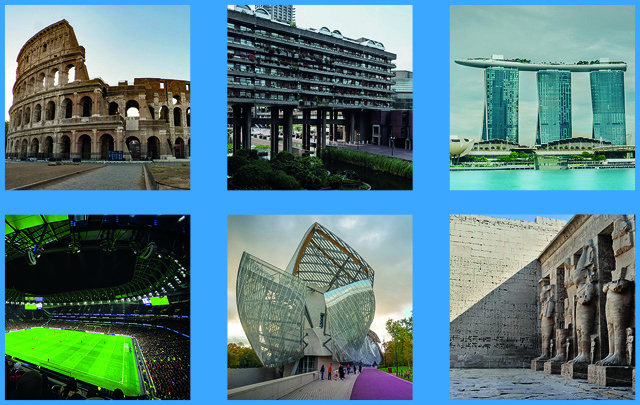Day in, day out we get to work with clients who manage some of the most incredible buildings and estates in the world. So, we wanted to set the MRG team a challenge and asked them to pick their favourite building.
Each week we will be publishing a new group of buildings, spanning the globe from London to Kuala Lumpur, built in 1600 BC right through to 2022 AD.
The Colosseum, Rome
By Ben Duffill
This was difficult as I have been incredibly fortunate to have had the chance to recruit Estate Leaders for some of the most iconic buildings/estates in the UK and Ireland. Some of these include the Houses of Parliament, Natural History Museum, Kew Gardens, UCL, Royal Opera House, Trinity College Dublin and Guy’s & St Thomas’ Hospital, but I am going to opt for Rome’s Colosseum.
The extraordinary history of the Colosseum, together with the sheer scale and presence of the building, is breathtaking. The conservation and restoration work that has gone on over centuries, and continues to happen today, is also incredible.
On a personal level I also enjoyed a brilliant family trip to visit Rome, and the Colosseum. Whilst there we enjoyed an expert guided tour by my then 8 year old son, who was studying Ancient Rome at school.

The Barbican Estate, London
By Alison Shine
The Barbican Estate has always fascinated me – as has all brutalist architecture – because it’s so divisive. I think it’s beautiful and striking. Completed in 1982, it’s nestled in the middle of the City of London, so it’s incredible how quiet it is walking around the Estate. The Barbican Arts Centre is home to a variety of events and The Barbican Conservatory is a must-see. Home to over 1,500 species of plants and trees, it’s the second biggest conservatory in London after Kew Gardens, and the cascading greenery spilling over the concrete balconies makes it feel like something out of a dystopian fantasy. The Barbican is truly a wonderful piece of London heritage.
Chamberlin, Powell and Bon was a British firm of architects whose work involved designing the Barbican Estate. Whilst it no longer exists, they are considered one of the most important modernist architectural firms in post-war England.
Marina Bay Sands Hotel, Singapore
Opened in 2011, Marina Bay Sands is one of the world’s most iconic and recognisable hospitality developments ever built. At the time, it was the most expensive standalone casino property globally, valued at around SG$8bn and was developed by the Las Vegas Sands Corporation. It continues to be a landmark and key feature of the Singapore skyline.
I’ve visited Singapore 4 times in my life (all while much younger, backpacking) and during my most recent trip, I finally stayed at the hotel and got to experience the glass sided infinity pool with views out over the city – it was incredible. With over 2,500 rooms, convention centre, shopping mall, museum, casino and the sky park (the instantly recognisable boat-shaped platform across the three 55-storey podiums), this is a fully integrated resort designed with architectural significance in mind. The infinity pool is also the longest elevated swimming pool anywhere in the world (650 ft above the ground) which is incredibly cool when you think about the physics of pumping water from ground level (1,450 cubic metres) on a daily basis.
I am also a big fan of the architect on this project, Moshe Safdie, who is the creative mind behind other visually striking civic and heritage projects in Asia such as the Jewel Changi Airport, The Kaufman Centre of Performing Arts as well as one of my favourite residential developments, Habitat 67 in Montreal.
Tottenham Hotspur Stadium, London
The New Tottenham Hotspur Stadium is a modern state of the art stadium. It was designed by the architectural practice, Populous, who designed the main stadium for the London 2012 Olympics, as well as Wembley Stadium and the 2000 Sydney Olympics Stadium.
The way they’ve managed to retain an authentic nod to the original White Hart Lane whilst bringing it forward into the 21st century, is remarkable.
What makes it so unique and special is the level of attention to detail in every aspect of its construction including the stadium having its own micro-brewery and a bespoke sliding pitch.
It’s incredible how such a huge construction, covering such a large space, has this level of bespoke design touches, giving it a real feeling of identity.
Louis Vuitton Foundation, Paris
By Olly Piltz
Frank Gehry’s Louis Vuitton Foundation Building reveals forms never previously imagined until today and is a reflection of the unique, creative and innovative project that is the Fondation Louis Vuitton. To produce his first sketches, Frank Gehry took inspiration from the lightness of late 19th-century glass and garden architecture, it is a building like no other and consequently my favourite building.
The Valley of the Kings, Egypt
Based in Ancient Egypt, this resting place of pharaohs and powerful nobles was built and developed over a period of about 500 years, from the 16th to 11th century BC. Still standing to this day and a major tourist attraction, incredibly new ante chambers are still being discovered and no one really knows how much more there is!
I love this ‘estate’ because it truly has stood the test of time.
Missed Week 2? You can read all about it here.
Missed Week 3? You can read all about it here.
Missed Week 4? You can read all about it here.
Missed Week 5? You can read all about it here.
Missed Week 6? You can read all about it here.
